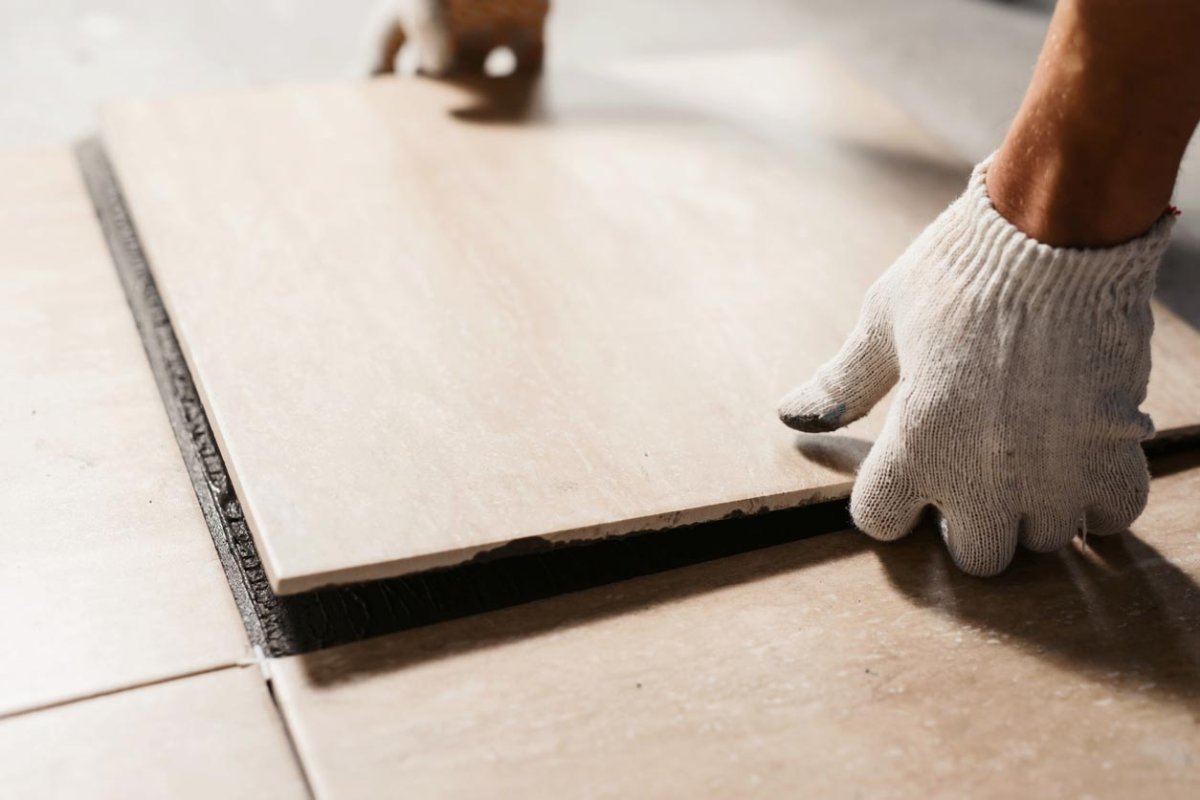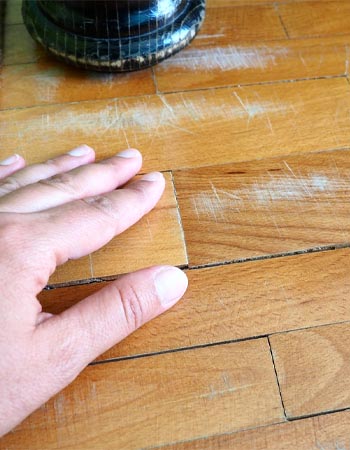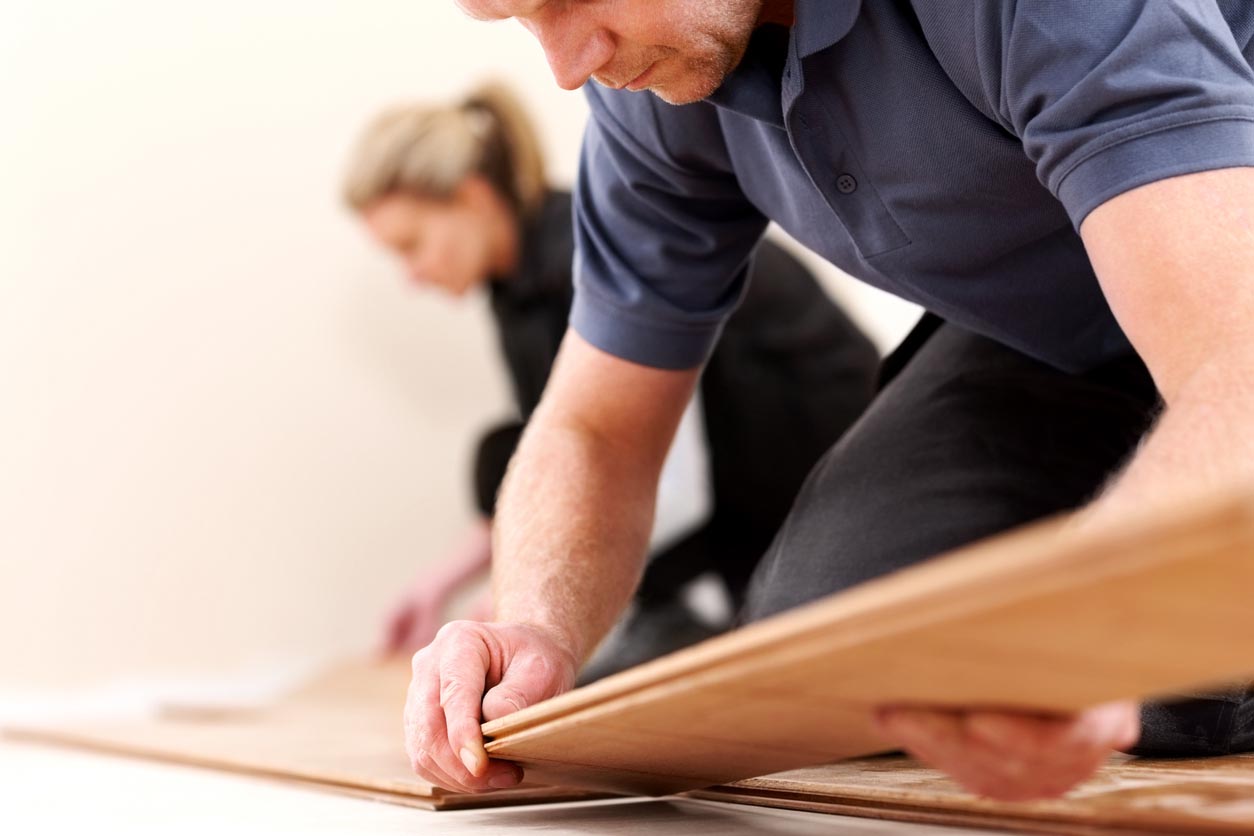

We may earn revenue from the products available on this page and participate in affiliate programs. Learn More ›
Q: When we bought our home years ago, the hardwood floors on the ground floor, tiling in the bathrooms, and carpeting in the bedrooms were big selling points—everything was in fabulous condition. Recently, though, I’ve started to notice that it’s all looking a little shabby. How do I know when it’s time to replace flooring?
A: Often, elements of a home can slowly start to show their age over time, and then all at once everything needs refreshing or replacing. Flooring does hard work: it gets trampled by kids and pets, becomes covered in water and bits of mud and leaves, and takes on spills and dropped items. Sometimes all that is needed is a good cleaning, such as a professional carpet cleaning, serious work on grout and some tile sealer, or a good refinishing or polishing of hardwood products. Eventually, though, cleaning can’t bring the flooring back to its original glory and it’s time to consider replacement.
The signs that it’s time to replace flooring differ based on the type of flooring. In general, any flooring that is deeply scratched, cracked, or torn needs to be replaced not just for aesthetic reasons, but also for hygienic ones. Bacteria and mold can fester and grow in deep cracks and be spread around the home. Similarly, floors that have sustained serious water damage will also need to be replaced, as water can threaten the structural stability of the floor as well as encourage mold growth. Finally, if the floor is noisy, badly discolored, or smells bad, it’s simply time to get something new. Hiring one of the best flooring companies, such as Empire Today, can be a significant financial investment, but it’s an opportunity to change up the look of the home and help the whole space feel fresh and new.

Carpet, hardwood, vinyl, and tile flooring.
Bob Vila has partnered with Empire Today to help you easily get beautiful new floors at a great price.
Free In-Home Estimates
Even floors that have been carefully maintained are likely to need replacement eventually. Visible wear and tear such as scratches, stains, or discoloration can all indicate that it’s time to consider flooring replacement.

Flooring that needs replacement isn’t an indictment of the homeowner’s housekeeping practices. Even floors that have been kept meticulously clean will eventually need to be replaced because of normal wear and tear and the abrasive nature of cleaning. Scratches can come from objects being dropped on the floor, pet toenails, or dirt and sand particles being tracked into the home and then crunched around underfoot until they’re swept or vacuumed up. Spills and stains happen fast—just one cup of spilled wine or fruit punch can leave stains that are almost impossible to remove, especially on light-colored floors. Over time, the angle of the sun through a window can fade flooring (especially carpeting, but all flooring is at risk) so much that the floor develops a line of slightly lighter discoloration, which can’t be cleaned out or removed. While these signs don’t all mean a flooring replacement is urgent or immediately necessary, they do mean it’s time to start planning a replacement project.
It’s possible to prolong the life of hardwood flooring by having it refinished, but once the boards become too thin to sand they will need to be replaced.
One of the many benefits of hardwood flooring is that it can be refinished several times throughout its lifespan. A professional will come in with commercial-grade sanders and remove approximately 1/32 of an inch of wood. The flooring can then be restained in a color of the homeowner’s choosing and sealed with either water-based or oil-based stain. There are several ways to determine how many times a hardwood floor can be refinished effectively. The quality of the flooring is the most important element, as the hardness of the wood and the thickness of the planks will be the deciding factor as to how much depth can be sanded off without losing structural integrity. Floors that are badly damaged also won’t have as many refinishings in them, as the contractor will need to remove more than the standard 1/32 of an inch if the scratches or gouges run deeper than that. In addition, the work done by previous refinishing contractors will affect the total number of potential refinishes—some unskilled refinishers may sand off uneven layers or remove considerably more material than is standard or necessary, reducing the opportunities to refinish. Once the boards become too thin or damaged to sand down, the flooring will need to be replaced.
Another sign that floors are nearing the end of their lifespan is when they make squeaking or creaking noises when they are walked on.
As floors age, they may suddenly begin squeaking or creaking when they’re walked on. The first thing to do is check that there isn’t a loose nail or screw. If the floor or subfloor has warped very slightly, then it’s possible a nail has become loose and the boards are flexing against the metal nail, creating a creaking or squeaking sound. If this is only happening in one or two places, homeowners can fix this themselves or look up who to hire to repair squeaky floors. However, if the squeaking is caused by thinning and warping boards that are rubbing against each other or subfloor panels that have thinned or loosened, it’s time to replace the flooring with something sturdier and more secure. Loose subfloor panels or floorboards aren’t just annoyingly loud; they can indicate that a floor is slowly starting to come apart, which presents a danger.

Porous flooring materials such as wood or carpet can retain odors, so flooring replacement might be a good idea if a room has a stubborn stench.
Prompt cleanup and treatment of spills and pet accidents on porous flooring such as carpet can prevent odors from sinking in, but most homeowners can’t shampoo their carpet every week. Cooking odors, the scent of damp laundry piles, and cigarette smoke can settle deeply into the fibers of a carpet or the porous grain of unsealed wood flooring, eventually building up too much to eliminate. A lingering musty smell can also suggest that mold or mildew has formed in or underneath the flooring. At that point, it’s time to remove and replace the flooring.
Depending on the source of the odor, it may also be necessary to replace the subflooring. Subflooring is often made of oriented strand board (OSB) or plywood, both of which are also prone to absorbing odors. So even if the subfloor isn’t stained, it’s a good idea to consider replacing it as well.
Carpet can also trap dust and pollen, so people with persistent allergies may want to replace carpeted floors with a solid material such as wood or tile.
Even in homes where residents and guests remove shoes at the door, irritants such as pollen and dust can travel inside on hair and clothes and through the intake for heating and air conditioning units. Once inside, these allergens will settle to the ground and become deeply embedded in carpeting. The fine substances can be vacuumed, but especially if the area is also exposed to dampness, it will be difficult to completely remove these allergy triggers. According to the National Center for Healthy Housing, the ideal choice for allergy sufferers is to remove carpeting and replace it with hard flooring that is easier to keep clean and won’t absorb particles. Looking into the best hardwood flooring installers or the best tile installation companies may be a good place to start, as these materials are less likely to harbor dust and pollen.
Replacing carpet will come at a cost that can be difficult to consider when the carpeting is still in great shape, but researching the best time to buy flooring and carefully calculating how much flooring is needed can keep costs down while relieving what can be serious chronic symptoms for allergy sufferers.
If a section of flooring has sustained water damage, it’s a good idea to replace it as soon as possible to prevent mold growth and structural issues from developing.
Water is an enemy of wood and textiles. First, water can cause wood flooring or subflooring to warp, soften, swell, or even crack, especially if the subfloor has become soaked and it’s not immediately apparent on the surface. Warped flooring can also become a trip hazard if the water damage has swelled hardwood in high-travel areas of the home. If the water damage has gone undiscovered for a long time, it can even lead to sagging and rot.
Water-damaged flooring also provides an outstanding breeding ground for mold and mildew. According to the Environmental Protection Agency (EPA), it takes as little as 24 hours following water damage for mold growth to develop. In the dark, moist space between a subfloor and the flooring material, mold spores can grow swiftly and exponentially. A small patch of mold can be removed and cleaned up fairly easily, but once the patch has grown and spread it can be all over the home much faster than most people realize: in the HVAC ducts, in the bathrooms, in the ceilings, and in the walls. Depending on the type of mold that grows, it can range from being an annoyance to those who have mild allergies to causing dangerous lung infections.
Ideally, homeowners will want to consider immediately removing and replacing flooring that has been exposed to a significant or longer-term water source such as a burst pipe, a leaking window or roof, or a flood. Once the water problem is resolved, hasty removal of the water-damaged flooring and other materials involved in the water issue will prevent mold spores from settling into damp areas and growing. If the patch of mold takes up more than 10 square feet, homeowners will want to consider consulting a mold remediation professional to facilitate cleanup. Once the mold has been removed, a flooring professional can assist with the replacement.
Finally, if a flooring material has become outdated or doesn’t match the home’s decor, it may be time to replace it with a more modern alternative.
Sometimes the only reason to replace flooring is that the homeowner is simply tired of it. If there is high-quality flooring in a home when it’s purchased, there’s little reason to go to the expense of replacing it immediately, even if it’s not complementary to the new owner’s style. Eventually, though, once the initial spending spree of new homeownership has passed, it may be time to replace the flooring with something the homeowner likes better. Chances are that if the existing flooring was older, new flooring won’t just be more attractive and modern—it will be easier to clean, offer better insulation, and increase the potential resale value of the home. So it’s not just an aesthetic change; new, modern flooring can be a wise financial choice as well.

Homeowners who are ready to replace their flooring can consult a flooring expert for advice on the best materials for their home.
Based on the age and layout of a home, along with the climate in the area and the lifestyle of the home’s residents, there may be specific types of flooring that are better options than others. If a homeowner hasn’t shopped for flooring in a while (or has only flicked through a few websites), there may be new flooring options that they don’t even know about. Traditional options will be familiar, of course, but many companies now offer luxury products designed to reduce noise transfer and insulate the home, as well as hypoallergenic options and choices that resist normal wear and tear better than previous options. Also, flooring companies have tools that can allow a customer to see exactly what a type or color of flooring would look like in their home, which can prevent buyer’s remorse. Empire Today, for example, has a handy visualizer tool that’s intuitive to use. Flooring experts are familiar with all of the options available and can explain the benefits and drawbacks of each, helping homeowners balance potential costs against the benefits of replacement flooring.
- Check out the BobVila.com review of Empire Today.
For the best results, it’s also a good idea to have a flooring contractor take care of the new flooring installation.
In a few cases, flooring installation can be a DIY project. Some laminate and plank vinyl floors can successfully be installed by handy homeowners who have the right tools and experience, but hiring a professional installer will typically yield the best results.
For materials such as carpet, hardwoods, and tile, it’s generally best to leave the installation to the pros. First, if the subfloor has been compromised in any way, it’s critical that a professional assess it and make sure that it’s sound, replacing it if it isn’t. Installing new flooring over a damaged subfloor is a recipe for an expensive and disruptive teardown in a year or two.
Flooring takes a lot of wear, and professional installation can ensure that it will last as long as possible and hold up well under the strain. In addition, many flooring manufacturers require that the installation be done by professionals in order for the warranty to remain valid—they know that poor installation can reduce the lifespan of the product and result in excess claims. And frankly, the finish and appearance of the new flooring will be best if it’s installed by someone who really knows what they’re doing. It would be terribly disappointing to go to the expense of purchasing flooring only to be unhappy with the installation, because that floor is going to be in place for a long time, and errors and imperfections will stand out. A flooring company with a national footprint (such as Empire Today) has many flooring options to choose from, including some top-of-the-line proprietary flooring, as well as coupons to help reduce costs and a crew of pro installers who can make the experience of replacing your flooring more efficient and pleasant.

Carpet, hardwood, vinyl, and tile flooring.
Bob Vila has partnered with Empire Today to help you easily get beautiful new floors at a great price.
Free In-Home Estimates
